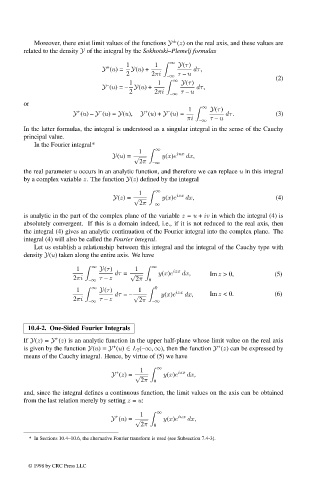Page 515 - Handbook Of Integral Equations
P. 515
Moreover, there exist limit values of the functions Y (z) on the real axis, and these values are
±
related to the density Y of the integral by the Sokhotski–Plemelj formulas
∞
1 1 Y(τ)
+
Y (u)= Y(u)+ dτ,
2 2πi τ – u
–∞
(2)
1 1 ∞ Y(τ)
–
Y (u)= – Y(u)+ dτ,
2 2πi τ – u
–∞
or
1 ∞ Y(τ)
+
+
–
–
Y (u) – Y (u)= Y(u), Y (u)+ Y (u)= dτ. (3)
πi τ – u
–∞
In the latter formulas, the integral is understood as a singular integral in the sense of the Cauchy
principal value.
In the Fourier integral*
∞
1 iux
Y(u)= √ y(x)e dx,
2π –∞
the real parameter u occurs in an analytic function, and therefore we can replace u in this integral
by a complex variable z. The function Y(z)defined by the integral
∞
1 izx
Y(z)= √ y(x)e dx, (4)
2π –∞
is analytic in the part of the complex plane of the variable z = u + iv in which the integral (4) is
absolutely convergent. If this is a domain indeed, i.e., if it is not reduced to the real axis, then
the integral (4) gives an analytic continuation of the Fourier integral into the complex plane. The
integral (4) will also be called the Fourier integral.
Let us establish a relationship between this integral and the integral of the Cauchy type with
density Y(u) taken along the entire axis. We have
∞ ∞
1 Y(τ) 1 izx
dτ = √ y(x)e dx, Im z >0, (5)
2πi τ – z 2π
–∞ 0
∞ 0
1 Y(τ) 1 izx
dτ = – √ y(x)e dx, Im z <0. (6)
2πi τ – z 2π
–∞ –∞
10.4-2. One-Sided Fourier Integrals
+
If Y(z)= Y (z) is an analytic function in the upper half-plane whose limit value on the real axis
+
+
is given by the function Y(u)= Y (u) ∈ L 2 (–∞, ∞), then the function Y (z) can be expressed by
means of the Cauchy integral. Hence, by virtue of (5) we have
∞
1
+ izx
Y (z)= √ y(x)e dx,
2π 0
and, since the integral defines a continuous function, the limit values on the axis can be obtained
from the last relation merely by setting z = u:
∞
1
+ iux
Y (u)= √ y(x)e dx,
2π 0
* In Sections 10.4–10.6, the alternative Fourier transform is used (see Subsection 7.4-3).
© 1998 by CRC Press LLC
© 1998 by CRC Press LLC
Page 497

